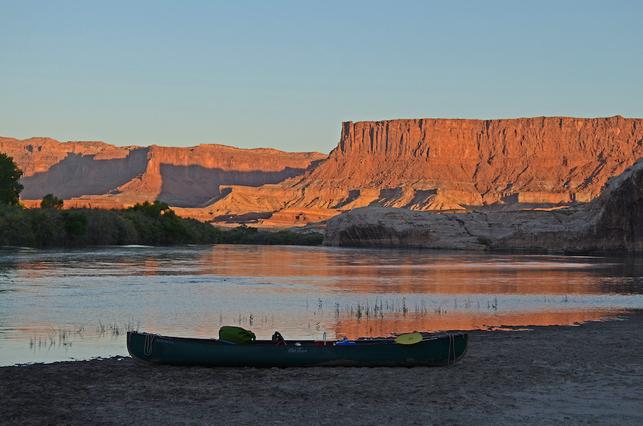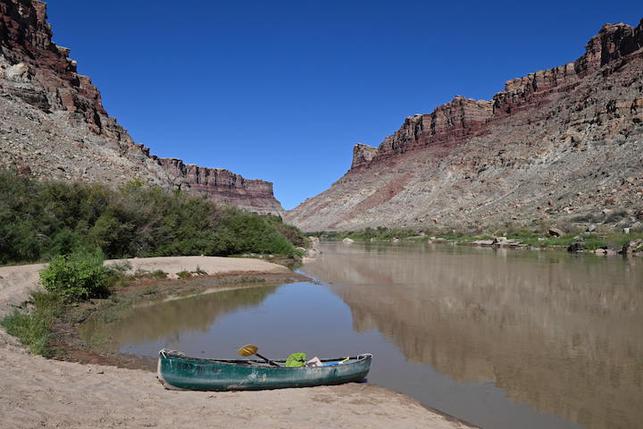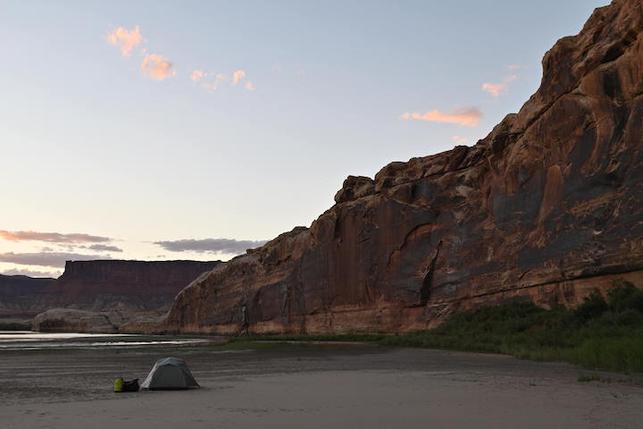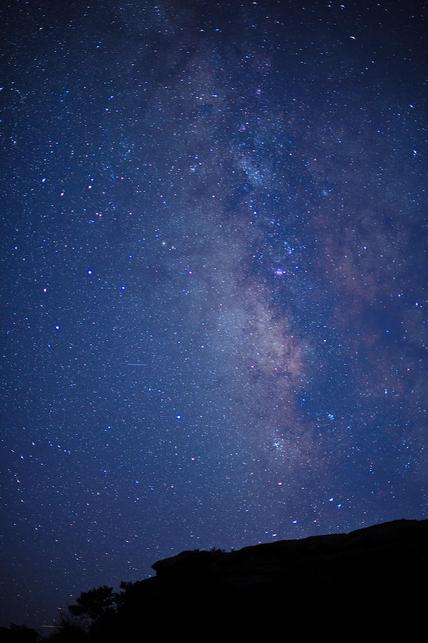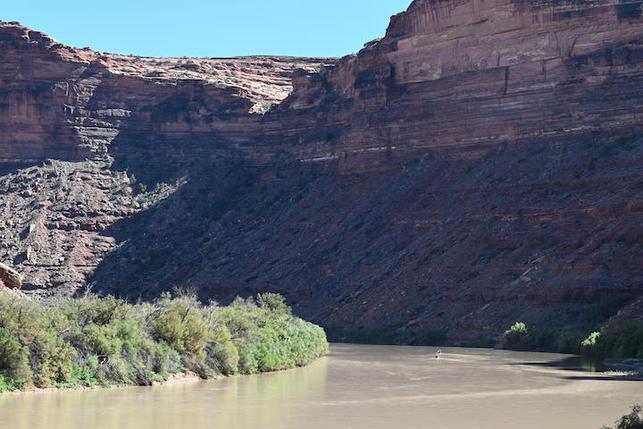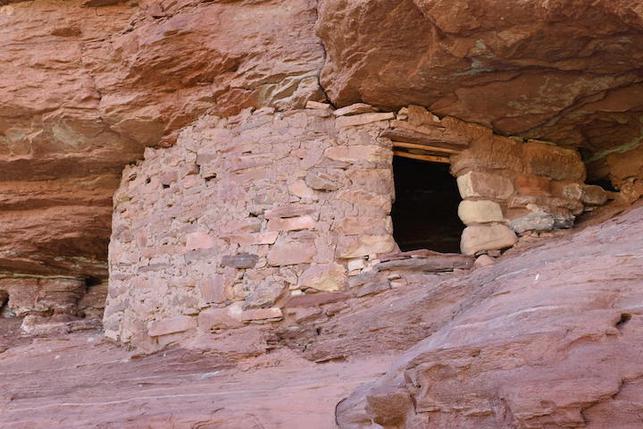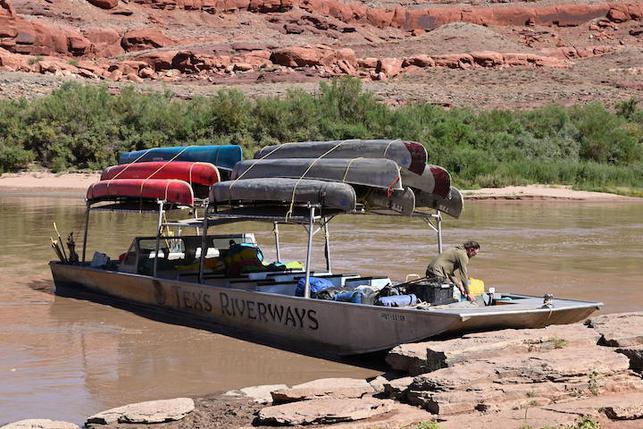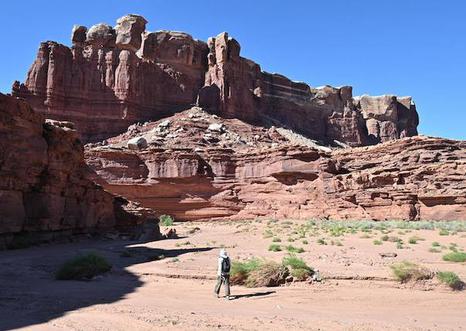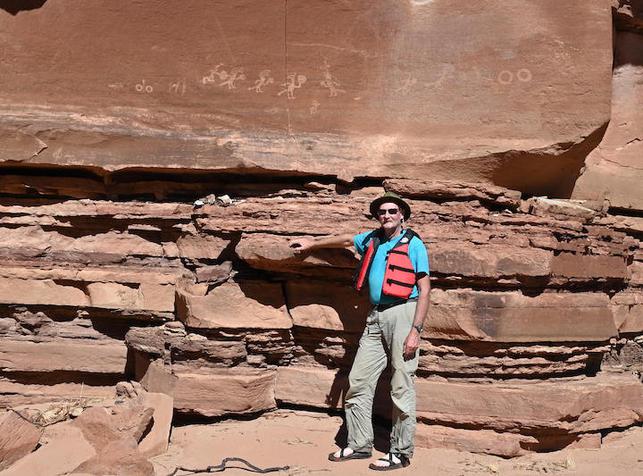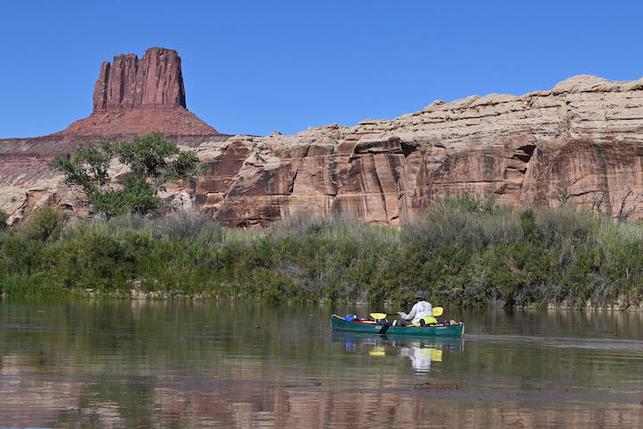
Georgia Wilderness Society
Adventures on the Green River of Utah
September 19 - 26, 2022
Irene & I arrived in Moab Sunday the 18th, having taken our time coming across Kansas and enjoying the mountains of southwestern Colorado. Jeff met us that day as well, and we all stayed at the Lazy Lizard Hostel (private rooms, $40). Most motels in Moab were over $200, so the Lizard was a steal. That night, we enjoyed the last cold beer or hot shower we'd have for over a week.
Monday morning, we loaded our gear on the outfitter's trailer and bus, and were taken over paved,then gravel desert roads to Ruby Ranch, where we put-in on the Green River. We were not alone.There were about 18 other boaters from Tex's, plus at least 4 rafts, plus paddle boarders and other assorted craft. So, there were maybe 40-50 people putting in at about the same time. A woman who spoke to Irene seemed amazed that we were packing so lightly. Most folks had huge coolers (we had none), plus a wide assortment of luxury items. At the end, we saw a 20-pound propane tank with grill, endless coolers filled with cold drinks and steaks, and 4 canoes rigged as 2 catamarans, with a 3'-4' deck between, piled several feet high with gear. We saw a flotilla of rafts, each rigged with Bimini tops (sun shades). These westerners know how to party and live in the lap of luxury on river trips.
Irene & I rented a 17' canoe, & Jeff rented a 15'. We had to rent a portable toilet and fire pan, and Jeff was nice enough to carry them since he had more room in his boat. We started down river about 11:40. I decided we should make around 10 miles the first day, then average about 15 thereafter, to cover the 97 miles of the Green, plus several miles of the Colorado, in 7-8 days. The high, red-rock canyons were beautiful, with the canyons of the first few days being narrower than the latter part of the trip. We hiked a little into a side canyon, Three Canyon, which Major John Wesley Powell had explored on his trips down the Green & Colorado in the 1860s.
Tom Payne ran this trip a few years ago and liked it so much he decided to do it again. I told him Irene & I would go on it this year. Unfortunately, we lost Tom in January. I took over as coordinator, and we found an opening with the shuttle company, Tex's Riverways, in Moab, Utah. It was scheduled for Sept. 19-26, 2022. Four of us signed up, which filled the slots that were open on the shuttle boat. At the last minute, Ben Thompson had to drop out due to illness in the family. That left Jeff Sorensen, Irene and I. In the end, all three of us made a month-long vacation of it, although we only spent about 10 days as a threesome.
Day 1 (Monday). Finding a place to take a break or camp was a challenge. The banks are lined with almost impenetrable walls of willow & tamarisk. I had been told that, this late in the season, there would be lots of sandbars exposed by the low water. We didn't see that many, at least not that were high enough above water level, but we did find a nice one to camp on that first night, when we stopped about 3:10, after covering about 11 miles. The sandbar was roughly 2' above water level, backed by cliffs maybe 150'-200' high.
Day 8 (Monday). We packed up and placed our gear near the shore, ready for our pickup. The jet boat came by to begin it's pickup with the most distant campers, so it came back to us on its upstream run about 11:15. Each pickup took about 20-30 minutes to get all the gear and people properly stowed, with the boats being tied on top. Our ride 50 miles up the Colorado, almost to Moab, took about 2 hours, running 30 mph, as the boat wove back and forth to remain in deep water. The driver told me the 47' boat draws about 16" of water on plane, but nearer 3' when dead in the water. I was kind of surprised that we never ran aground, as the river is always shifting its channel and is very silty. The ride up was nearly as enjoyable as the paddle down, and the scenery beautiful.
Day 2 (Tuesday). Painted on one cliff was "Launch Marguerite, 9/1/1909". This was just one of many signs of man that we saw. Ranching and mining have been going on in these parts since the mid 1850s. We began looking for a campsite at around mile 18, but the few we saw were occupied, so we finally found a good, empty site after paddling about 23 miles.
(Tom and John Houser in particular left us very suddenly and unex-pectedly. In case my fate is similar, I want to thank you all for the enjoyment and enrichment you've brought to our lives. Irene & I joined GWS in 2004, and it's been very rewarding to paddle, hike and hang around with you. GWS has a lot of really good people, with interesting stories to tell. We try to look after one another, and work with one another to enjoy our time together. I hope to get to see you for many more years.)
It was a great trip and well worth it. Since we were all planning a month-long trip, we decided it was better to rent boats than drag our personal craft all over the country. Total cost of the Green River trip for Irene and I was about $1,050, and about $530 for Jeff's share. There are several different put-ins, so you can vary the number of days you spend on the river. If you haven't done this trip, I'd recommend it.
Day 4 (Thursday). Another dew-covered morning, so didn't get on the water until 11:30. We had the place to ourselves, and were surrounded by high cliffs and towers, so it was enjoyable to sit around and soak up the scenery. We stopped around noon at Fort Bottom to hike up to a stone tower, reportedly built hundreds of years ago by the Anasazi. From this butte, several hundred feet high, there was a beautiful view up and down the river. We could also see an old, roofless cabin beside the river. Further down river we saw what Major Powell named the Butte of the Cross, which appeared initially to him a cross lying down, but turned out to be two buttes, one behind the other. We camped after covering about 9.6 miles. We saw no other people this day. Near dusk, we had our first and only campfire. It was still fairly warm and we rarely had shade in camp, so we erected a tarp each day to ward off the sun. The sky was beautifully dark and moonless each night, and the stars of the Milky Way really stood out in the dry desert air. We were 25 miles or so from Moab, the nearest town, and it has only about 5,500 people, so there was very little light pollution.
Day 7 (Sunday). We had a short paddle to the confluence of the Green & Colorado. We saw our first motorboat just before reaching the Colorado. This boat ran aground repeatedly in the shallow water (we had also run aground several times over the course of the week). Upon reaching the Colorado, we debated on camping our last night at the confluence, where there was a huge sandbar, or going further down river. The jet boat that was to pick us up needed deep water at the pickup site, so we continued down nearly 3 miles to a nice site at Spanish Bottoms with rare shade under small cottonwoods. So we took that spot on high ground. We had great views up and down the river, and high cliffs and columns to catch the sunlight late in the day. Total mileage for the day was around 12, reaching camp at 2:50.
We mostly sat around, enjoying the shade and watching the shadows creep up the walls of the canyon. Irene kept the two of us well fed during this trip. We had dehydrated meals one day, but the rest of the time she came up with delicious meals that were not pre-made. I think Jeff mostly relied on backpacking dehydrated meals. Just before our last supper, I had one more thing to do that was important to me. We raised our cups as I dedicated the trip to Tom's memory in particular, but also to the other GWS members that we've lost over the years. They were with us in memory and spirit, though not in person.
Day 5 (Friday) dawned with a beaver swimming upstream past our camp. The water was coming up fast, with a rise of a foot since last night. No rain was nearby, so we assumed a flash-flood had occurred way up stream. It turned out that the dam at Flaming Gorge Reservoir had released water. By the time we got on the river, Jeff's boat, which he had left near the edge of the sandbar, was getting wet, and the sandbar was half the size of the previous afternoon. Much small debris was also drifting by, and this kept up another day or two. The outfitter had warned us to tie up the boats or get them well above water level, so we were extra careful after this.
We passed some ancient granaries along the river and had a pretty lazy day, often just drifting. The White Rim Road, a 4-wheel-drive-only road, was beside the river for 5 miles or so, and we occasionally heard and/or saw Jeeps and such traveling along it. There were also the occasional cattle herd beside the river, as well as some evidence of mining and ranching operations. So it was not the wilderness experience I initially thought we would have, but we were still very isolated and far from Atlanta's maddening crowds and traffic. Paddled 11 miles before camping, about 1:00, in a side canyon, hauling our gear well above water level. Jeff and I explored the canyon by foot. He saw lots of interesting minerals in this land of layers and layers of sedimentary rocks. Away from the river, the terrain was very much desert, with prickly pear cactus, scraggly juniper, and some cottonwoods. We enjoyed watching the shadows creep up the cliffs as the rock became increasingly red near sunset.
Day 6 (Saturday). The water level had dropped, so our boats and gear had to be hauled farther to the water for put-in. The river is very muddy and would clog filters quickly, so Irene & I took 14 gallons of water (Jeff took a similar amount), plus two buckets and alum to settle water for filtering. In the end, we needed no more for drinking, but we did sometimes use settle water for cleaning ourselves. One night at bedtime, after a particularly muddy shoreline, I used settled water to clean Irene's feet as she sat in the tent with her filthy feet outside, then cleaned mine before putting on socks and clean pants to sleep in. This helped to keep our sleeping bags clean.
We stopped at a side canyon to view some petroglyphs. The campsite we chose had a granary nearby. I climbed up to take a look in it, and Jeff & I explored the canyon beyond. As was often the case, access in this canyon ended at a dry waterfall, but the canyon continued on at a higher level. Mindful that we were miles from medical help, and had no cell signal or satellite phone, we were always careful not to take too many risks while exploring on foot. Another group stopped briefly to walk through our camp and visit the granary.
Each day, we got on the water anywhere between 8:30 and 11:30. (Hey, this was a lazy vacation for 3 retired folks!) We also wanted to let the dew dry on our tents/tarp before packing up. Light rain began late on day 2, and continued off and on through day 3.
Day 3 (Wednesday) dawned cloudless, and the remaining days were mostly the same, with the temperature dropping some from around 90 degrees the first day. We hiked into Hell Roaring Canyon where an inscription was carved into the rock which read "D Julien, 1836." What we saw from this spot was little changed over the two centuries since. We entered the canyons of Canyonlands National Park this day. Camped after 22 miles. Again, we didn't start out to paddle this far, but had trouble finding good camp-sites. Put-in at 8:30 and camped at 3:35.
Life is short.
Go on an adventure while you can!
